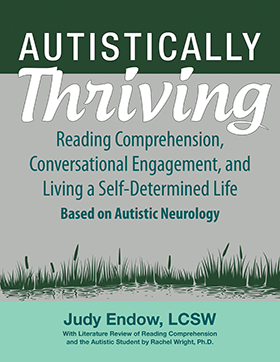Besides having sensory differences, autistic people generally are known for their particular style of thinking. We tend to have a quite literal and concrete way of thinking. Most autistics think in pictures. Temple Grandin, undoubtedly the most famous autistic the world over, actually wrote a book entitled Thinking in Pictures: My Life with Autism (Grandin, 1995, 2006).
I think differently than typical people think. Many people with autism have a visual way of thinking. It is not an inferior way of thinking. It is just different. Even so, because autistics are measured according our deviation from the typical standard of normal our different ways are often assumed to be inferior or less than.
The world is set up according to what is comfortable and efficient for neuromajority people. This means the interface to society, while comfortable and efficient for most people, is actually an uncomfortable and inefficient interface for autistic people. Undoubtedly this contributes to our awkward appearance as we go about our daily lives every day interfacing with the mismatch-to-our-neurology societal and social contexts all around us.
Often times it feels as if the world is not our home. Many autistics report a pervasive sense of not belonging, being an alien and feeling that no matter what they do they never fit in anywhere they go. I believe this has to do with needing to live out our lives in this everyday context that is not a comfortable fit with our neurology.
When the context changes and adult autistics are among their autistic friends that pervasive feeling of not belonging is largely absent. Many of us have had discussions about this over the years. If home is where you belong then we know that even though we must go out and live in a world mismatched to us, we can always come home to our autistic community. For many of us this means meeting up at autism conferences.Thinking differently than the majority of the population needs to be better understood. For too long the problems that result from autistics simply being who they are have been addressed through a neuromajority lens. This isn’t a criticism, but instead, a statement of fact.
We all assume shared understanding. We are rewarded for using this assumption when solving problems for others because most of the time when we look through the lens of our own neurology and figure out if-I-were-doing-that-it-would-mean-this we are rewarded in that we come away with a correct guess. We can then go on to solve the problem by looking through this lens. Every once and awhile we are not successful when we use this strategy. These are the times when the behavior we are trying to figure out is generated by autistic neurology.
Here is an example: It is not uncommon for early childhood students to cry at drop off when mom or dad leaves. You have taught early childhood for many years and know that getting the child interested in something else will help the tears dissipate. Except this year you are unable to get Carter, a student with autism, distracted. In fact, rather than dissipating, Carter’s tears become worse over the couple of hours he is with you. His crying gets louder and louder, taking on an angry feel and after about an hour his cries become pitifully mournful. You have tried everything you can think of to be helpful to Carter. You have offered a variety of toys, movement activities, alone time, alternative seating, using a first/then schedule, alternative lighting, the quiet corner, taking him for a walk and offering favored snacks and drinks. Nothing helped. Every day was the same scenario with Carter.
I know this teacher as I consulted at her school district. She was in fact trying to implement all the sorts of supports that autistic students find helpful. Why was nothing working for Carter? It took some time, but we did figure it out. Carter’s difficulty had to do with his visual thinking style. When his mom left, because he could not see her it felt as if she had died. This was because Carter had not yet learned to hold the picture of mom in his head.
How did I come to figure this out?
First I determined that Carter’s sensory system was regulated during the time before arriving at school by having a conversation with his mother. I also learned from his mom that Carter had the same crying episodes whenever she left him with her sister or mother. Nobody could console him. If mom was away for more than a few hours he would fall asleep exhausted only to wake up to start the whole crying episode over from the beginning.
Next, I looked for clues on how Carter was taking in, processing, storing and retrieving information. He was not able to contribute any information himself so my guess was based on his crying – increasing anger over time (during which time he would throw things, kick, hit, scream) that gave way to mournful cries (during which time he would isolate himself, turning his back to any activity and not interact with any adult who approached him). It looked like a grief process. I suspected that he was not able to hold the picture of mom in his head. Thus, it felt to him as if she had died when mom was simply out of sight.
To test out my hypothesis mom was asked to bring along a picture of herself to give to Carter when she dropped him off. Carter was free to carry around this picture whenever he wished, which he did most of the time for a few weeks.
Having access to the picture of mom made all the difference for Carter. He was able to participate in the early childhood programming. He only had a few crying episodes during the first couple of weeks that happened when he set down the picture of mom in order to play and then noticed he didn’t have it. Carter’s teacher helped him make “a home for mom” by standing the picture in the chalk tray of the blackboard and drawing a little box around it. Carter could look up and see mom in the box whenever he wished. He was happy with this remedy.
This is but one illustration that shows the importance of understanding the autistic thinking style. Just like no two neuromajority people think exactly alike, but share lots of similarities so is it that no two autistics think exactly alike, but share lots of similarities. For all my life the onus has been on me, the autistic, to figure out the majority thinking style and make accommodations for it. It has been difficult at times, but I have been able able to do so. Because of my own experience in being able to learn how a foreign-to-me thinking style works I am sure that neuromajority folks can do it too. Yes, you can learn how autistic thinking style works! You do not even need to figure it out all by yourself, but can instead read this book and others like it.
I find when I start problem solving with the autistic neurology rather than with the behavior I am being called in to solve that i am able to solve the problem more quickly and efficiently while respecting and actually supporting the uniqueness of the student’s own neurology.
I get called upon for consultation because students are having “problem behavior.” After listening to the problem and all the things that have been tried to solve the problem I then observe and sometimes meet with the student.
Note: This blog is a selection(pg 31) from the following book:
Order book here
BOOKS BY JUDY ENDOW
Endow, J. (2019). Autistically Thriving: Reading Comprehension, Conversational Engagement, and Living a Self-Determined Life Based on Autistic Neurology. Lancaster, PA: Judy Endow.
Endow, J. (2012). Learning the Hidden Curriculum: The Odyssey of One Autistic Adult. Shawnee Mission, KS: AAPC Publishing.
Endow, J. (2006). Making Lemonade: Hints for Autism’s Helpers. Cambridge, WI: CBR Press.
Endow, J. (2013). Painted Words: Aspects of Autism Translated. Cambridge, WI: CBR Press.
Endow, J. (2009). Paper Words: Discovering and Living With My Autism. Shawnee Mission, KS: AAPC Publishing.
Endow, J. (2009). Outsmarting Explosive Behavior: A Visual System of Support and Intervention for Individuals With Autism Spectrum Disorders. Shawnee Mission, KS: AAPC Publishing.
Endow, J. (2010). Practical Solutions for Stabilizing Students With Classic Autism to Be Ready to Learn: Getting to Go. Shawnee Mission, KS: AAPC Publishing.
Myles, B. S., Endow, J., & Mayfield, M. (2013). The Hidden Curriculum of Getting and Keeping a Job: Navigating the Social Landscape of Employment. Shawnee Mission, KS: AAPC Publishing.




